Tomato Poached Salmon with Charred Cabbage Couscous
Feb 04, 2024, Updated Apr 04, 2025
This post may contain affiliate links. Please see our disclosure policy.
This is my take on Alison Roman’s Tomato Poached Fish – it’s poached salmon in brothy deliciousness topped on a bed of charred scallion cabbage and couscous for a well balanced and incredibly tasty 30 minute meal.
Looking for more beautiful salmon dishes? Try my sauce Vierge on lemon steamed salmon, Lemon Pepper Salmon Bowl, or my Turmeric Salmon with fresh herbs.
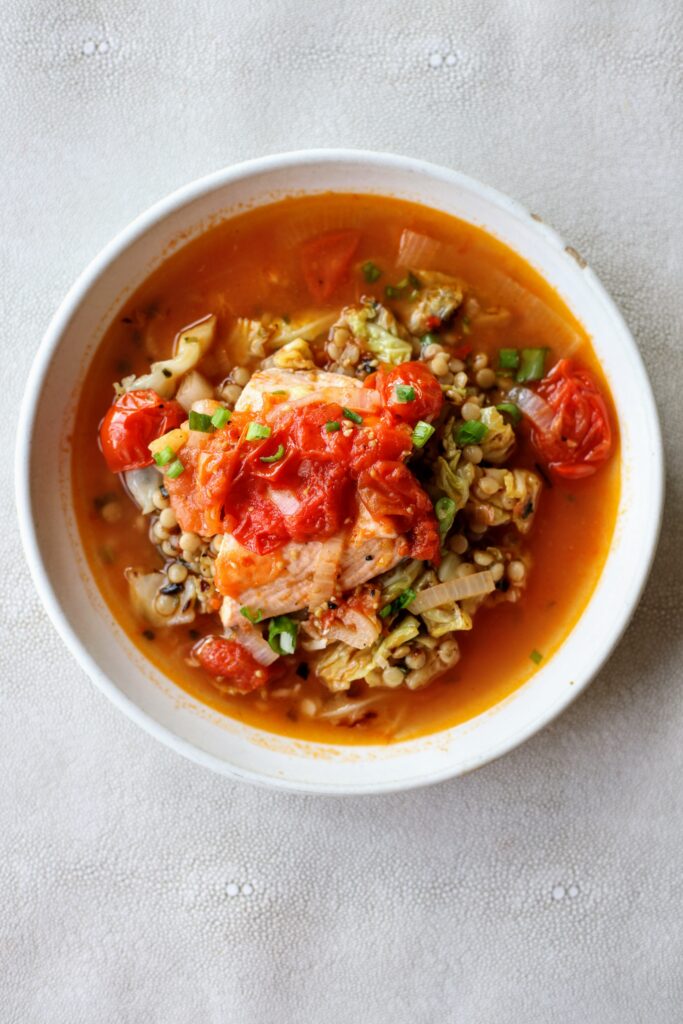
Ingredient Notes
Fish – I use salmon because it’s the fish I eat most regularly, however any white fish like halibut, cod, or even petrale sole would work great. Try and get the fish the day of or the day before you make this recipe.
Tomatoes and Shallots – The base of the broth is made from sautéing olive oil, cherry tomatoes, and shallots. I use 1 pint of cherry tomatoes, but feel free to use 2 whole tomatoes diced, or canned tomatoes if you’re in a pinch.
Savoy cabbage – Savoy cabbage is a type of cabbage that is a bit more flavorful and textured that regular green or Napa cabbage. I use half of a medium sized head in this recipe, and save the other half to stir fry into dishes the rest of the week.
Pearled Couscous – I use the larger pearled couscous in this recipe, which are like little balls of pasta. I find that this type of couscous sits well in the broth and goes well with the fish and cabbage. If you only have the finer couscous, I would recommend you use an orzo pasta or other small pasta instead.
Step by Step Instructions
Step 1: Bring a pot up to a boil for the couscous. Once at a boil, salt the water and cook according to package instructions. Usually, this is about 5 minutes on medium high heat. Once cooked, drain and rinse with cold water.
Step 2: While you’re waiting for the water to boil, cut the cabbage – halve the cabbage, slice out the core, then cut into 1” pieces. The inner layers will release, so there’s no need to peel the cabbage layers. Set aside in a large bowl.
Step 3: Prep the shallot and garlic – thinly slice the shallot and mince the garlic.
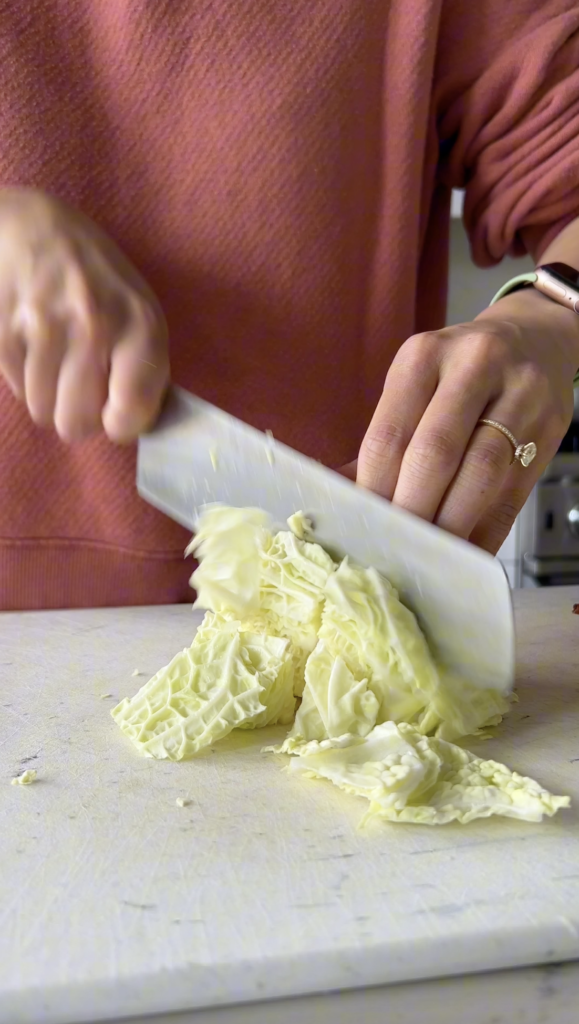
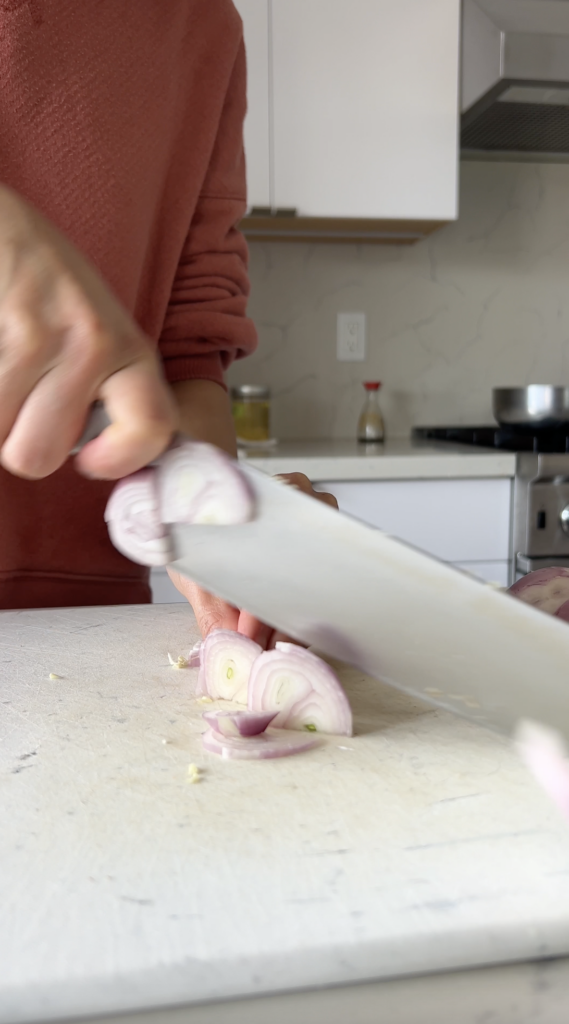
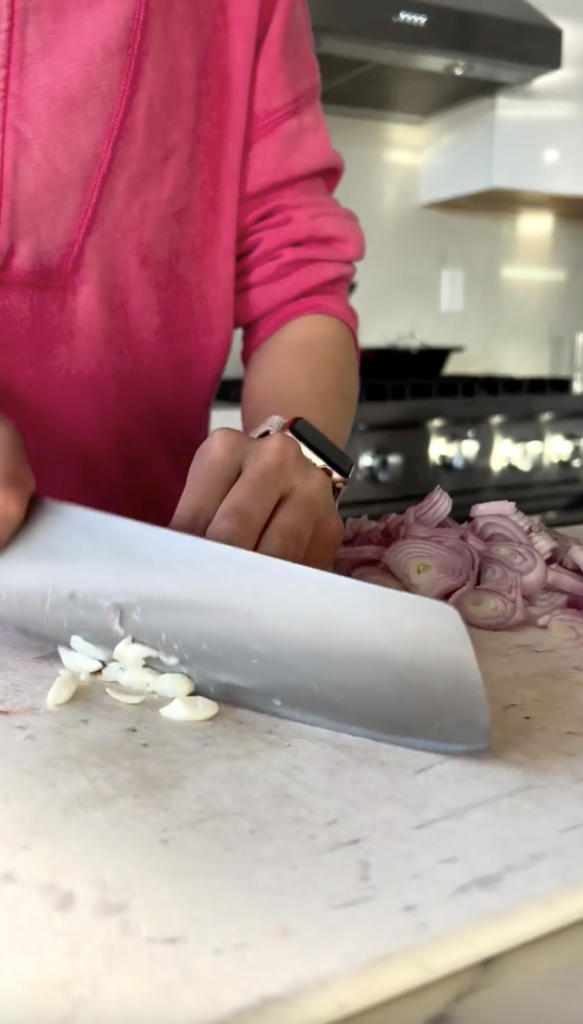
Step 4: Heat a pan on medium high heat. Add the olive oil, tomatoes, shallots, and a pinch of salt. Cover and cook for 5 minutes.
Step 5: Prep the salmon – cut into 6 ounce portions, then season each side with kosher salt.
Step 6: After 5 minutes, open the lid and add the minced garlic and red pepper flake. Cook for 30 seconds, then add the 2 cups of water, another big pinch of salt, and a bay leaf. Bring this up to a simmer, then add the salmon and lower the heat to medium low. Cook for 10 minutes uncovered, and make sure the fish is fully submerged in the liquid.
Step 7: After 5 minutes, gently flip the fish (this is optional, but I do it).
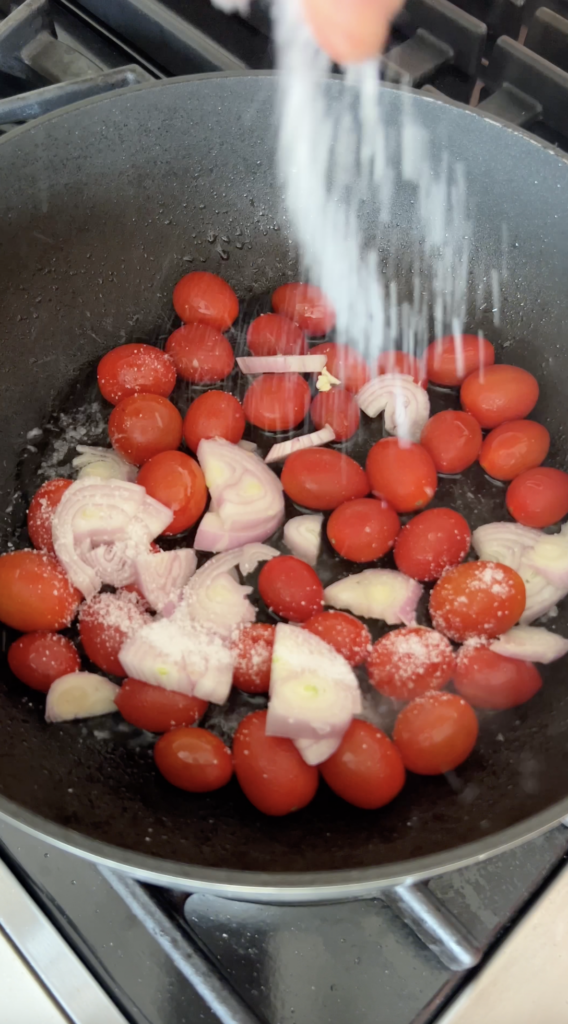
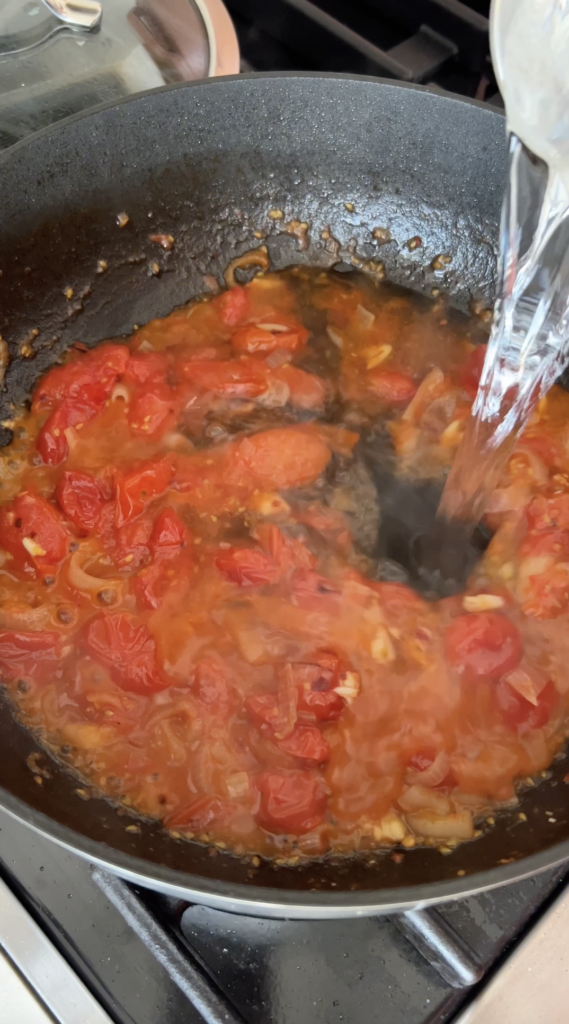
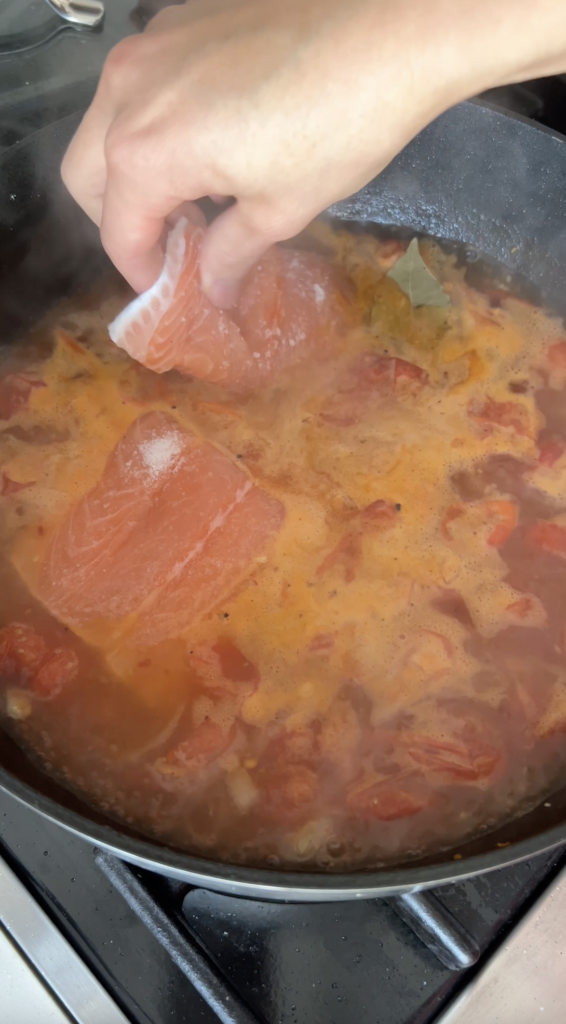
Step 8: While the fish is cooking, finish the couscous. In a cast iron pan (or you can use the same pan as what you cooked the couscous in), add 2 tablespoons of oil. Reserve some scallion green tops for garnish, and add the remaining scallions to the pan. Cook until they are dark brown, about 2 minutes.
Step 9: To the charred scallions, add the chopped cabbage, and cook for another 4-5 minutes, stirring occasionally. Once the cabbage is also slightly browned at the edges, season with a kosher salt and black pepper. Turn off the heat and add the cooked couscous. Give everything a stir.
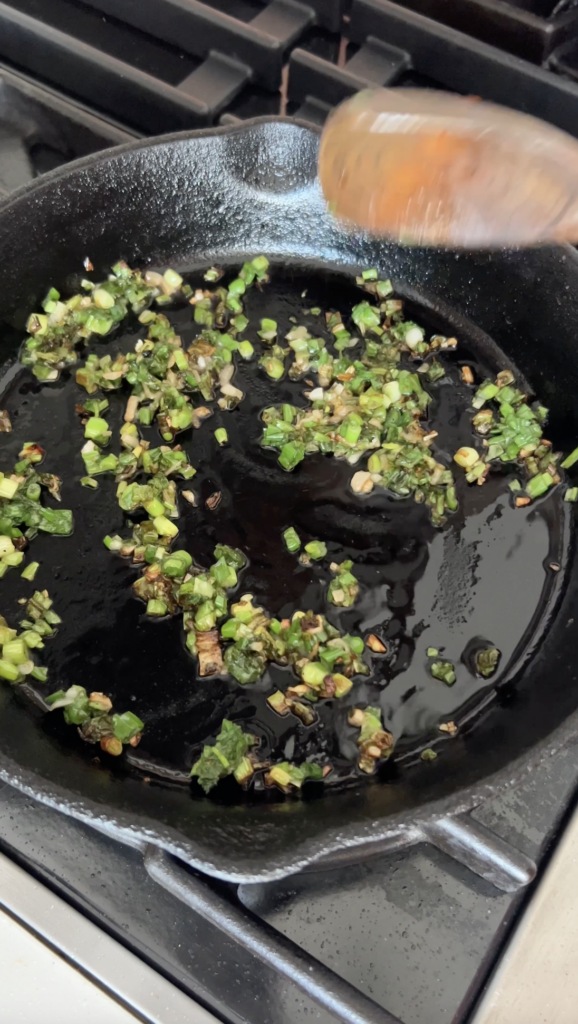
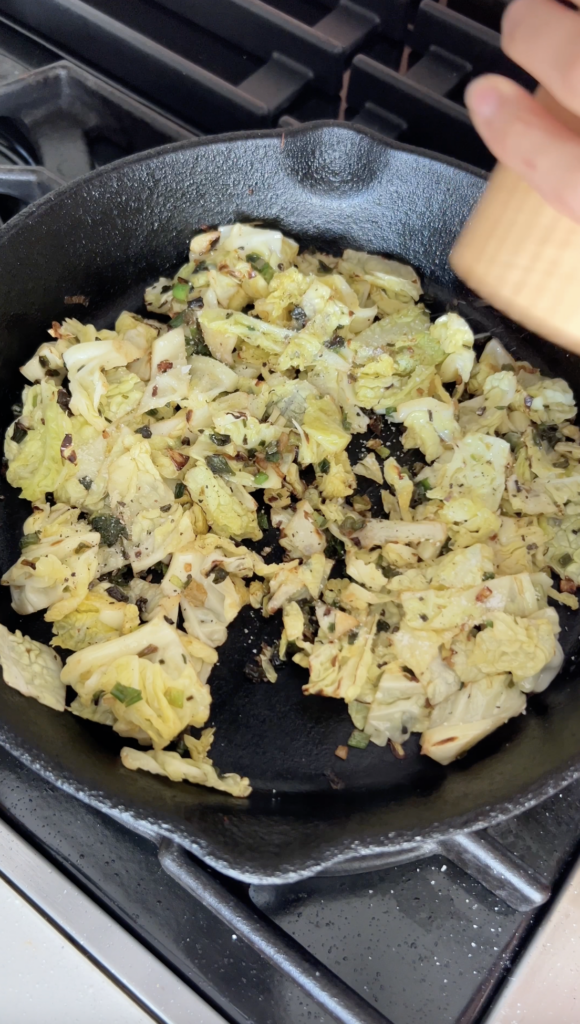
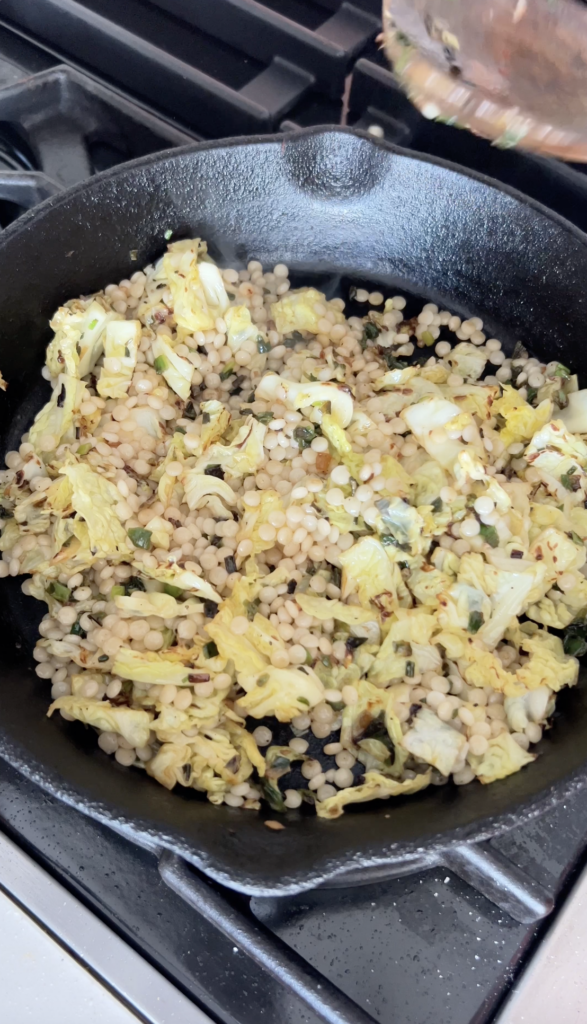
Step 10: Once the salmon has been poaching for 10 minutes, turn off the heat and taste the broth. Season with more kosher salt and black pepper as desired.
Step 11: Plate the couscous into a shallow bowl. Top with a piece of salmon and several spoonfuls of the broth. Garnish with a few sliced green scallions, and serve immediately.
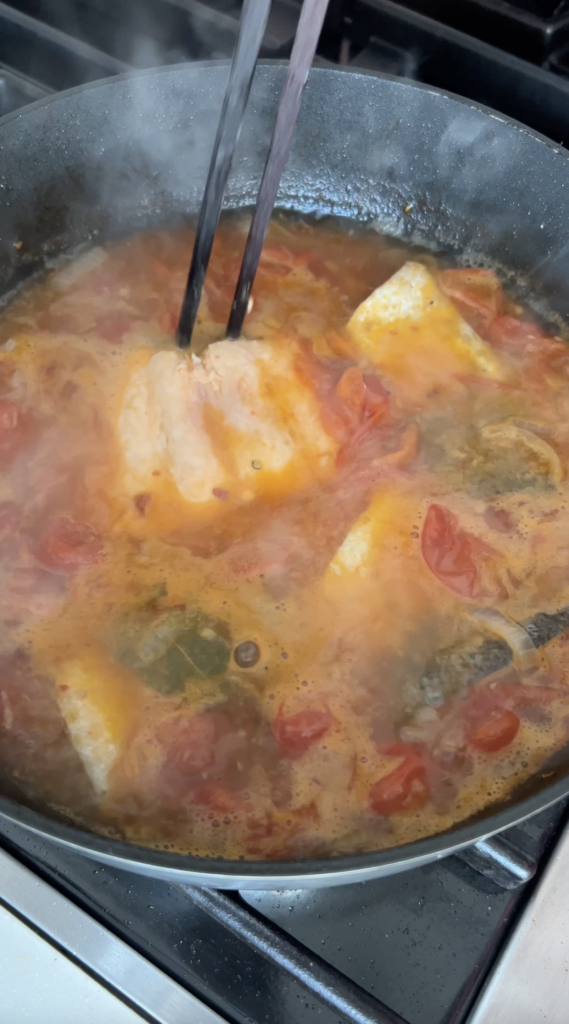
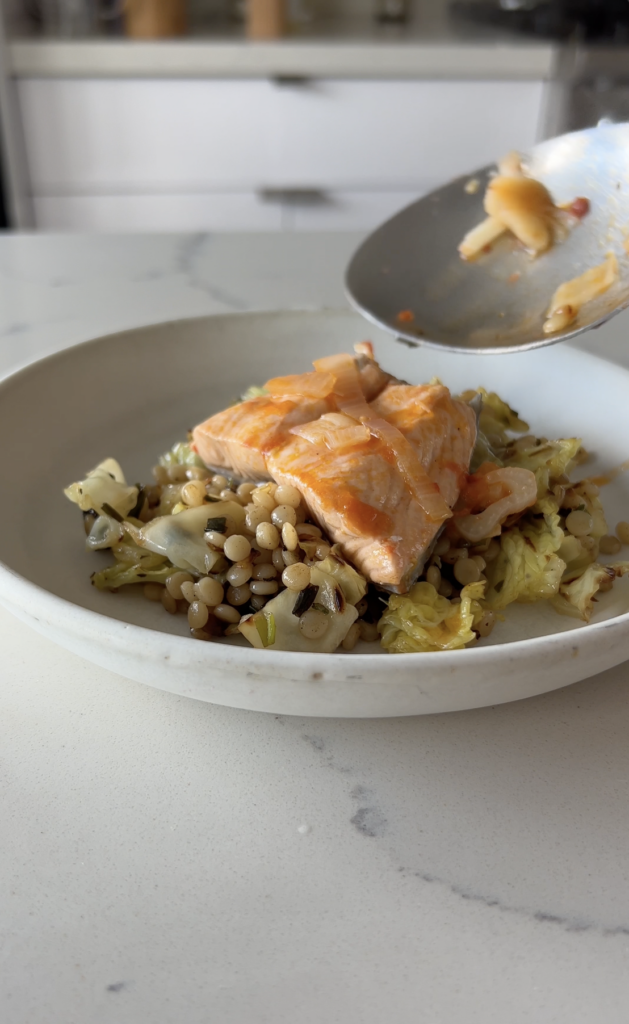
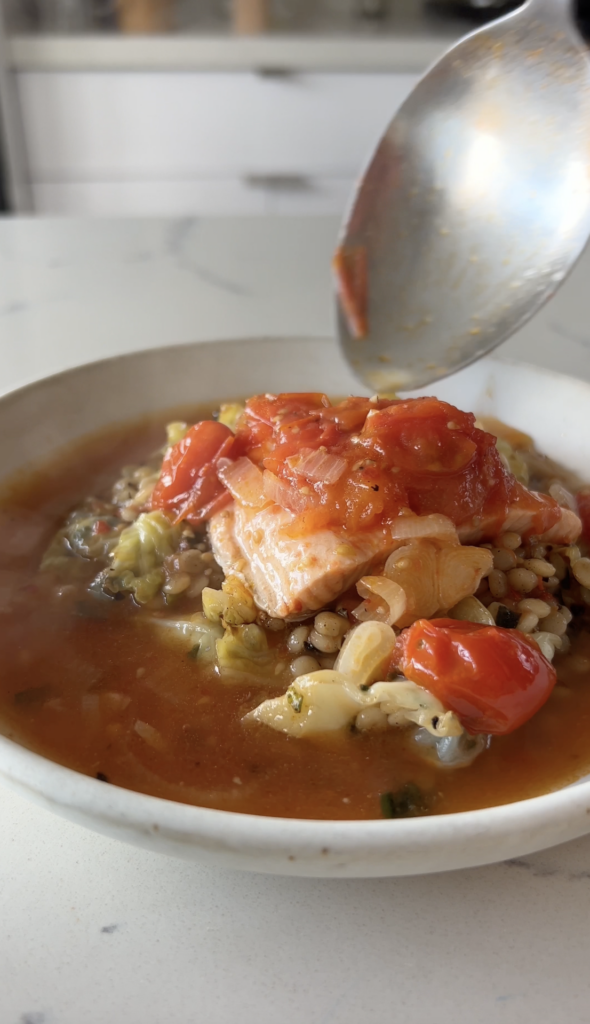
Recipe & Cooking tips
Tip 1 – Make sure to lower the heat BEFORE you add the fish into the broth. You want to bring your poaching liquid up to a simmer, but then reduce the heat so it is barely simmering. This will ensure that the fish very slowly cooks and get that’s perfect poached fish texture.
Tip 2 – Cover the cherry tomatoes and shallot as they sauté. This might not be the most traditional cooking technique, but it helps with oil and juices splattering all over the stove. I haven’t noticed a difference in flavor when moving to this method, and it saves me time during cleanup!
Tip 3 – Char the scallions on medium high heat until they are brown and look almost burnt. They will continue to cook with the cabbage, but you want most of the flavor developed before adding the cabbage. If you need to add the cabbage in 2 different batches, feel free to do so.
Storage and Reheating
Storage: Store the couscous separately from the salmon and broth. Each can be stored in an airtight container for up to 3 days.
Reheating: Gently reheat the salmon on the stovetop in the broth for ~5 minutes on medium high heat. Reheat the couscous separately. Remove the salmon when heated throughly, and top over the reheated couscous. If you’re in a pinch, you can use the microwave to reheat both the couscous and salmon together.
Freezing: You can freeze the couscous in an airtight container for up to 2 months. Defrost overnight, then reheat on the stovetop until warm. You can freeze the salmon and broth, but I wouldn’t recommend freezing it for more than 5 days.
Additions and Substitutions
Additions:
- Spice – if you love spicy things, feel free to double the amount of red pepper flake, and add a Serrano pepper into the tomato shallot mixture.
- Crispy Shallots – this would be a flavorful and beautiful topping
- Herbs – cilantro and mint are traditional to Allison Roman’s original recipe, which would be a really nice garnish.
Substitutions:
- Savoy cabbage – Instead of cabbage, feel free to use broccoli or broccolini.
- Couscous– if you want to make this recipe gluten free, you can substitute the couscous for a gluten free pasta, cooked rice, or even cauliflower rice.
- Salmon – Swap out the salmon for a white fish, or even eggs or silken tofu. When making this with eggs, you can poach the eggs directly in the broth. Cook at a below a simmer for 5-7 minutes, or until your preferred doneness. Silken tofu can be poached in the broth in 2″ cubes for 10 minutes.
FAQ
You can use a meat thermometer to check the internal temperature of the fish. If the thickest part is at 135 or higher, the salmon is ready. If you don’t have a meat thermometer, you can flake off a piece of the fish and see if flakes off easily.
The couscous contains gluten, but you could substitute this for a gluten free pasta or even cooked rice.
Video Tutorial
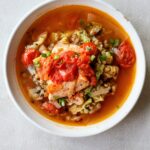
Tomato Poached Salmon
- Total Time: 30 minutes
- Yield: 4 servings 1x
Description
This is my take on Alison Roman’s Tomato Poached Fish – it’s brothy deliciousness topped on a bed of charred scallion cabbage and couscous for a well balanced and incredibly tasty 30 minute meal.
Ingredients
- 1 shallot
- 2 cloves garlic, minced
- 1/4 teaspoon red pepper flake
- Kosher salt
- Black pepper
- 3 tablespoons olive oil
- 1.5 lbs salmon
- 1 pint of cherry tomatoes
- 2 cups of water
- 1 bay leaf
For the charred scallion cabbage couscous:
- 1 cup dried couscous
- 1 bunch of scallions, chopped
- 1 tablespoon oil
- 1/2 head of savoy cabbage, cut into 1” pieces
- Kosher salt
- Black pepper
Instructions
- Bring a pot up to a boil for the couscous. Once at a boil, salt the water and cook according to package instructions. Usually, this is about 5 minutes on medium high heat. Once cooked, drain and rinse with cold water.
- While you’re waiting for the water to boil, cut the cabbage – halve the cabbage, slice out the core, then cut into 1” pieces. The inner layers will release, so there’s no need to peel the cabbage layers. Set aside in a large bowl.
- Prep the shallot and garlic – thinly slice the shallot and mince the garlic.
- Heat a pan on medium high heat. Add the olive oil, tomatoes, shallots, and a pinch of salt. Cover and cook for 5 minutes.
- Prep the salmon – cut into 6 ounce portions, then season each side with kosher salt.
- After 5 minutes, open the lid and add the minced garlic and red pepper flake. Cook for 30 seconds, then add the 2 cups of water, another big pinch of salt, and a bay leaf. Bring this up to a simmer, then add the salmon and lower the heat to medium low. Cook for 10 minutes uncovered, and make sure the fish is fully submerged in the liquid.
- After 5 minutes, gently flip the fish (this is optional, but I do it).
- While the fish is cooking, finish the couscous. In a cast iron pan (or you can use the same pan as what you cooked the couscous in), add 2 tablespoons of oil. Reserve some scallion green tops for garnish, and add the remaining scallions to the pan. Cook until they are dark brown, about 2 minutes.
- To the charred scallions, add the chopped cabbage, and cook for another 4-5 minutes, stirring occasionally. Once the cabbage is also slightly browned at the edges, season with a kosher salt and black pepper. Turn off the heat and add the cooked couscous. Give everything a stir.
- Once the salmon has been poaching for 10 minutes, turn off the heat and taste the broth. Season with more kosher salt and black pepper as desired.
- Plate the couscous into a shallow bowl. Top with a piece of salmon and several spoonfuls of the broth. Garnish with a few sliced green scallions, and serve immediately.
Equipment
Notes
Tip 1 – Make sure to lower the heat BEFORE you add the fish into the broth. You want to bring your poaching liquid up to a simmer, but then reduce the heat so it is barely simmering. This will ensure that the fish very slowly cooks and get that’s perfect poached fish texture.
Tip 2 – Cover the cherry tomatoes and shallot as they sauté. This might not be the most traditional cooking technique, but it helps with oil and juices splattering all over the stove. I haven’t noticed a difference in flavor when moving to this method, and it saves me time during cleanup!
Tip 3 – Char the scallions on medium high heat until they are brown and look almost burnt. They will continue to cook with the cabbage, but you want most of the flavor developed before adding the cabbage. If you need to add the cabbage in 2 different batches, feel free to do so.
- Prep Time: 15 minutes
- Cook Time: 15 minutes
- Category: Quick and easy
- Method: Stovetop
- Cuisine: American
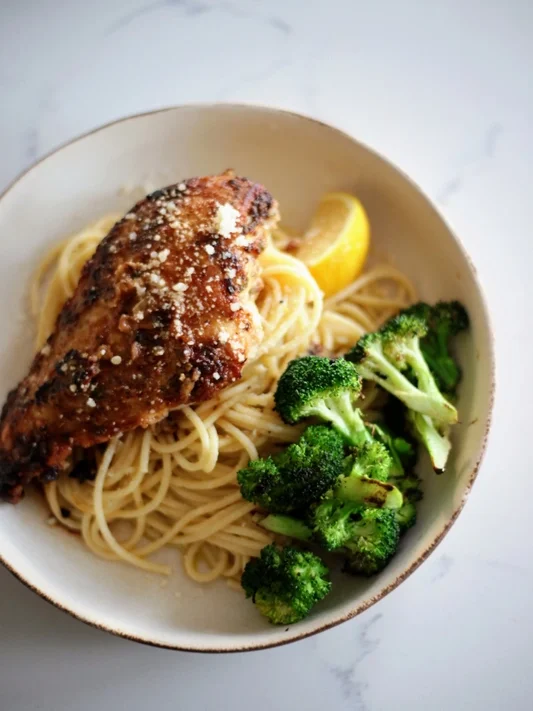
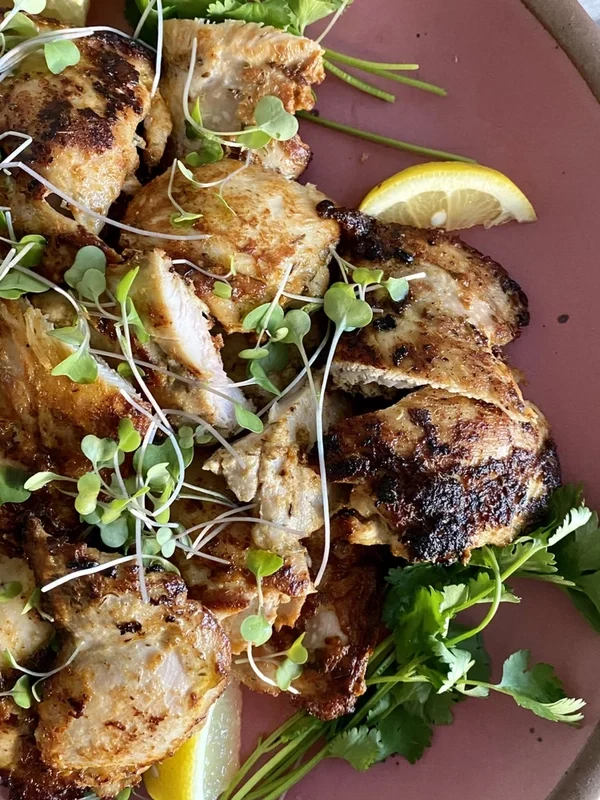
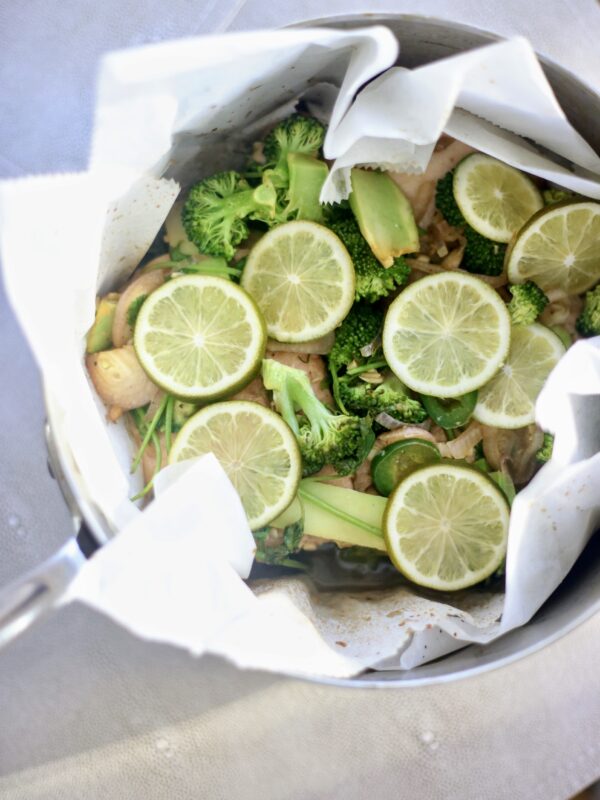
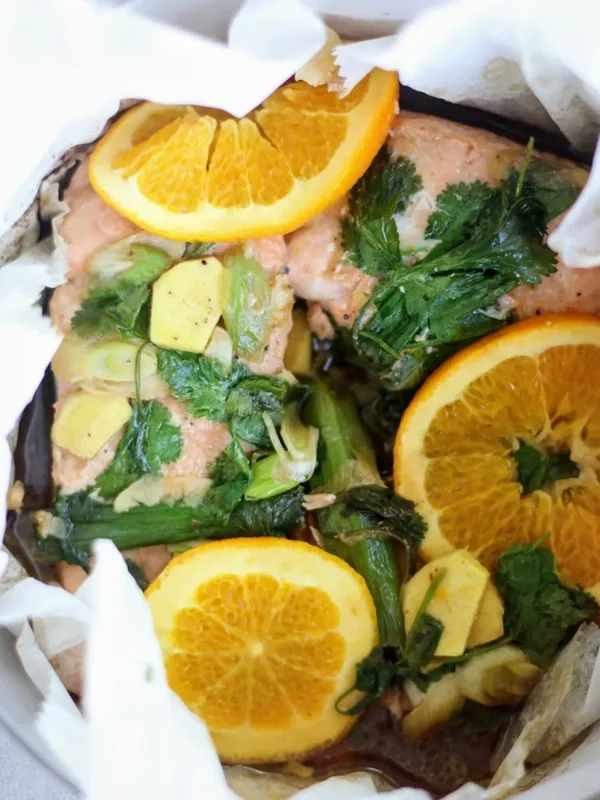
made this dish tonight and it was delicious! followed the recipe except i used four cloves of garlic and two bay leaves. will definitely make again!
so happy to hear and glad you enjoyed it. thanks for sharing Diana 🙂